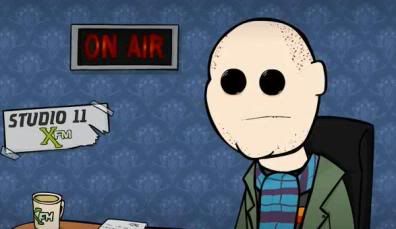Bomb suspects 'fled in rickshaws'
Bilal Abdulla (L) and Mohammed Asha
Two alleged terrorists escaped in rickshaws after leaving car bombs close to a night club in central London, Woolwich Crown Court has been told.
The devices planted by Dr Bilal Abdulla and now-deceased Kafeel Ahmed were found after Tiger Tiger staff called an ambulance for a customer, jurors heard.
CCTV footage said to show the men driving a car filled with explosives into Glasgow airport was also shown.
Dr Abdulla, 29, and Dr Mohammed Asha, 27, deny conspiracy to murder.
Dr Abdullah, from Paisley, and Dr Asha, from Newcastle-under-Lyme, who is alleged to have helped in the planning, also pleaded not guilty to conspiracy to cause explosions.
The court was told Dr Abdulla was the passenger in a Jeep 4X4 driven by Mr Ahmed into the doorway of Glasgow airport's terminal on the afternoon of 30 June 2007.
Mr Ahmed was said to have made number of attempts to crash through the entrance and "repeatedly struck the pillars or door frame until the vehicle became trapped".

Having failed to detonate the vehicles in London they were prepared to do literally anything to achieve an explosion
Prosecutor Jonathan Laidlaw QC
The CCTV footage shown in court was taken by cameras inside and outside the building.
Passengers waiting to check-in could be seen turning, before running away in every direction.
Images from another camera outside the building showed the four-wheel drive vehicle engulfed with flames.
Prosecutor Jonathan Laidlaw QC said: "The airport was experiencing its busiest day of the year...
"For those present it must have been the most terrifying of experiences when they appreciated what was happening."
'Fire bomb'
Mr Laidlaw told the court: "It is clear that having failed to detonate the vehicles in London they were prepared to do literally anything to achieve an explosion which was bound, having been successful, to result in them losing their lives."
He said Mr Ahmed and Dr Abdulla lit and threw petrol bombs during the incident.
An expert who examined the vehicle described it as a "mobile fire bomb" that would be manually set alight, the jury heard.
Police found gas canisters, fuel containers and broken glass bottles which appeared to be the remains of petrol bombs.
Mr Laidlaw said: "It is possible that the liquefied petroleum gas cylinders could have exploded or ruptured during any fire, particularly if the regulators had been interfered with or opened.
"Such an event might well have resulted in a large fireball and the ejection of sections of the cylinders from the car with high velocity with the obvious consequent risk to persons some distance away."
Police also found a burned laptop computer in the Jeep that prosecutors said appeared to contain a draft of Dr Abdulla's will.
Mr Laidlaw said: "This document is addressed to, amongst others, the leaders of jihad in Iraq, to [Osama] Bin Laden and to the brothers or soldiers of jihad in Iraq, Afghanistan, Chechnya, Palestine and other areas of the world...
"The attacks he was planning were intended to kill. They were in revenge for the injustices as the defendant sees them that the British and American people and their armies visit on the Muslim communities."
Gas vapour
The jury was told there were 556 customers in the London nightclub when the bombs were discovered the day before the Glasgow airport incident.
The cars, packed with gas canisters, petrol and nearly 900 nails, were left outside the nightclub and a bus stop in the West End, but failed to explode, the jury has been told.
Mr Laidlaw said Dr Abdulla parked a green Mercedes car outside Tiger Tiger in Haymarket at 1.24am.
The club's bouncer and manager noticed gas vapour and a strong smell of petroleum vapour coming from the car as they met paramedics at about 1.40am.
A fireman who arrived at the scene opened the Mercedes' door and pulled a gas canister from its rear footwell.

We suggest that the purpose of placing nails in the cars is too obvious to state. But it does provide a clear sign as to what the bombers intended
Jonathan Laidlaw QC
Mr Laidlaw said it was at that point the Bomb Squad were called to the scene and the area was evacuated.
The second car, a blue Mercedes, was parked by Mr Ahmed at 1.18am in Cockspur Street near the nightclub. It was noticed by a traffic warden who issued it with a ticket.
At 3.14am it was towed away to a car pound in Park Lane, where it was later made safe with a remote device after police realised it contained a bomb.
Rickshaw escape
An expert said the car bombs would have created an explosion or a series of explosions if they had been successful, Mr Laidlaw told the court.
But they probably failed to ignite because there was not enough oxygen for flames to burn as the fuel-air ratio in the vehicles had become too high, the court heard.
Mr Laidlaw said the prosecution suggested the purpose of placing nails in the cars was "too obvious to state".
Prosecutors said the two suspects were captured on CCTV leaving the area.
Mr Ahmed boarded a rickshaw in Piccadilly Circus at 1.39am and Dr Abdulla used the same method to get away from the area, Mr Laidlaw said.
The pair met again in Edgware Road at 2.05am.
The court was told that extremist Islamic literature and computer files were found at Dr Asha's home and he had made attempts to dump or destroy similar material.
Mr Laidlaw said he had been followed by undercover officers before he was arrested on the M6 on 30 June.
The trial continues.
http://news.bbc.co.uk/1/hi/uk/7663210.stm
Videos have also been posted!
Spoiler:










 Reply With Quote
Reply With Quote


Social Networking Bookmarks